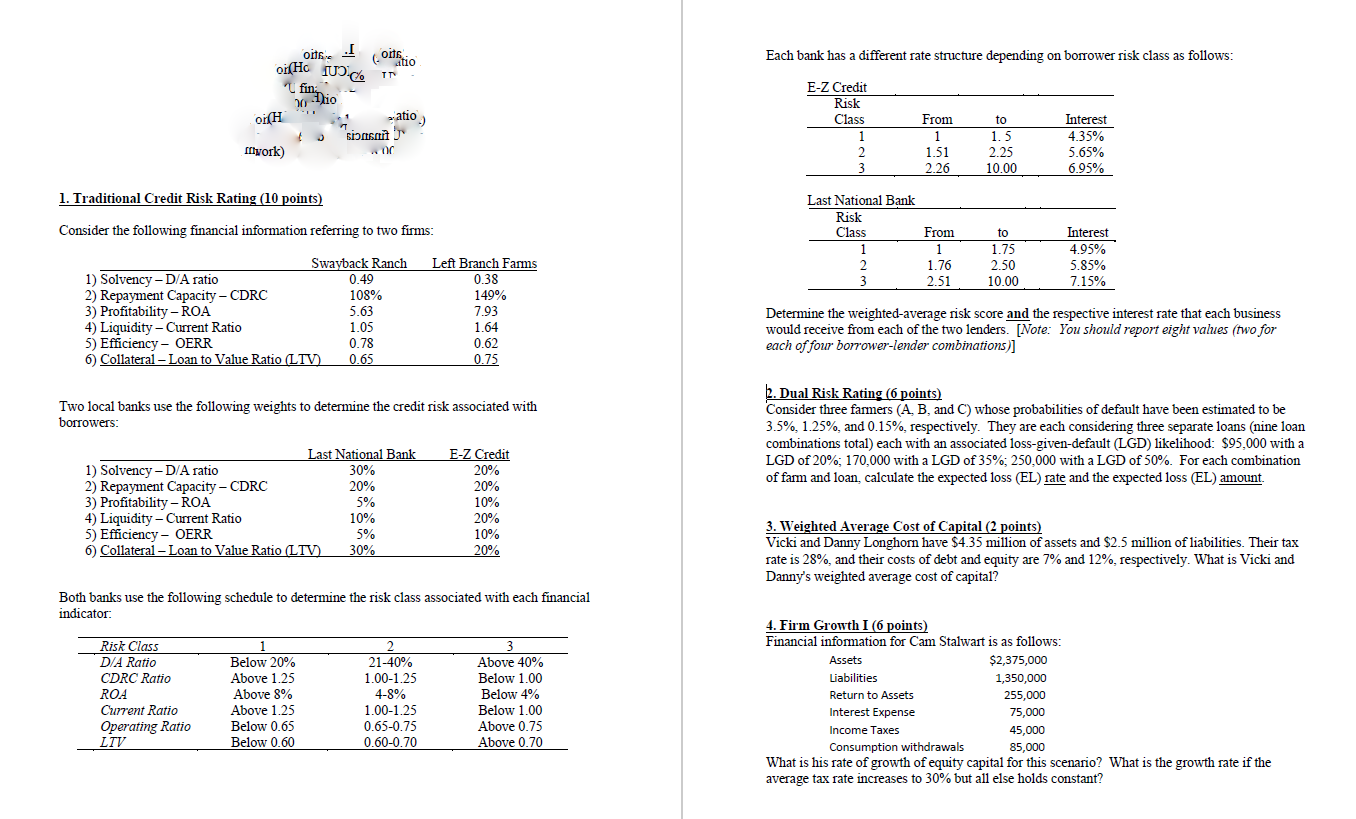
oite .I Contato or Ho UCIT fin Each bank has a different rate structure depending on borrower risk class as follows: 00 Dio or(H xatio) E-Z Credit Risk Class 1 2 3 to 1.5 2.25 [flyork) From 1 1.51 2.26 00 Interest 4.35% 5.65% 6.95% 10.00 1. Traditional Credit Risk Rating (10 points) Last National Bank Risk Consider the following financial information referring to two firms: Class 1 2 From 1 1.76 to 1.75 2.50 10.00 Interest 4.95% 5.85% 7.15% 2.51 Swayback Ranch 1) Solvency - D/A ratio 0.49 2) Repayment Capacity - CDRC 108% 3) Profitability - ROA 5.63 4) Liquidity - Current Ratio 1.05 5) Efficiency - OERR 0.78 6) Collateral - Loan to Value Ratio (LTV 0.65 Left Branch Farms 0.38 149% 7.93 1.64 0.62 0.75 Determine the weighted-average risk score and the respective interest rate that each business would receive from each of the two lenders. [Note: You should report eight values (two for each of four borrower-lender combinations)] Two local banks use the following weights to determine the credit risk associated with borrowers: 2. Dual Risk Rating (6 points) Consider three farmers (A, B, and C) whose probabilities of default have been estimated to be 3.5%, 1.25%, and 0.15%, respectively. They are each considering three separate loans (nine loan combinations total) each with an associated loss-given-default (LGD) likelihood: $95,000 with a LGD of 20%; 170,000 with a LGD of 35%, 250,000 with a LGD of 50%. For each combination of farm and loan, calculate the expected loss (EL) rate and the expected loss (EL) amount. Last National Bank 1) Solvency - D/A ratio 30% 2) Repayment Capacity - CDRC 20% 3) Profitability - ROA 5% 4) Liquidity - Current Ratio 10% 5) Efficiency - OERR 5% 6) Collateral Loan to Value Ratio (LTV) E-Z Credit 20% 20% 10% 20% 10% 20% 30% 3. Weighted Average Cost of Capital (2 points) Vicki and Danny Longhorn have $4.35 million of assets and $2.5 million of liabilities. Their tax rate is 28%, and their costs of debt and equity are 7% and 12%, respectively. What is Vicki and Danny's weighted average cost of capital? Both banks use the following schedule to determine the risk class associated with each financial indicator Risk Class D/A Ratio CDRC Ratio ROA Current Ratio Operating Ratio LTV Below 20% Above 1.25 Above 8% Above 1.25 Below 0.65 Below 0.60 21-40% 1.00-1.25 4-8% 1.00-1.25 0.65-0.75 0.60-0.70 Above 40% Below 1.00 Below 4% Below 1.00 Above 0.75 Above 0.70 4. Firm Growth I (6 points) Financial information for Cam Stalwart is as follows: Assets $2,375,000 Liabilities 1,350,000 Return to Assets 255,000 Interest Expense 75,000 Income Taxes 45,000 Consumption withdrawals 85,000 What is his rate of growth of equity capital for this scenario? What is the growth rate if the average tax rate increases to 30% but all else holds constant? oite .I Contato or Ho UCIT fin Each bank has a different rate structure depending on borrower risk class as follows: 00 Dio or(H xatio) E-Z Credit Risk Class 1 2 3 to 1.5 2.25 [flyork) From 1 1.51 2.26 00 Interest 4.35% 5.65% 6.95% 10.00 1. Traditional Credit Risk Rating (10 points) Last National Bank Risk Consider the following financial information referring to two firms: Class 1 2 From 1 1.76 to 1.75 2.50 10.00 Interest 4.95% 5.85% 7.15% 2.51 Swayback Ranch 1) Solvency - D/A ratio 0.49 2) Repayment Capacity - CDRC 108% 3) Profitability - ROA 5.63 4) Liquidity - Current Ratio 1.05 5) Efficiency - OERR 0.78 6) Collateral - Loan to Value Ratio (LTV 0.65 Left Branch Farms 0.38 149% 7.93 1.64 0.62 0.75 Determine the weighted-average risk score and the respective interest rate that each business would receive from each of the two lenders. [Note: You should report eight values (two for each of four borrower-lender combinations)] Two local banks use the following weights to determine the credit risk associated with borrowers: 2. Dual Risk Rating (6 points) Consider three farmers (A, B, and C) whose probabilities of default have been estimated to be 3.5%, 1.25%, and 0.15%, respectively. They are each considering three separate loans (nine loan combinations total) each with an associated loss-given-default (LGD) likelihood: $95,000 with a LGD of 20%; 170,000 with a LGD of 35%, 250,000 with a LGD of 50%. For each combination of farm and loan, calculate the expected loss (EL) rate and the expected loss (EL) amount. Last National Bank 1) Solvency - D/A ratio 30% 2) Repayment Capacity - CDRC 20% 3) Profitability - ROA 5% 4) Liquidity - Current Ratio 10% 5) Efficiency - OERR 5% 6) Collateral Loan to Value Ratio (LTV) E-Z Credit 20% 20% 10% 20% 10% 20% 30% 3. Weighted Average Cost of Capital (2 points) Vicki and Danny Longhorn have $4.35 million of assets and $2.5 million of liabilities. Their tax rate is 28%, and their costs of debt and equity are 7% and 12%, respectively. What is Vicki and Danny's weighted average cost of capital? Both banks use the following schedule to determine the risk class associated with each financial indicator Risk Class D/A Ratio CDRC Ratio ROA Current Ratio Operating Ratio LTV Below 20% Above 1.25 Above 8% Above 1.25 Below 0.65 Below 0.60 21-40% 1.00-1.25 4-8% 1.00-1.25 0.65-0.75 0.60-0.70 Above 40% Below 1.00 Below 4% Below 1.00 Above 0.75 Above 0.70 4. Firm Growth I (6 points) Financial information for Cam Stalwart is as follows: Assets $2,375,000 Liabilities 1,350,000 Return to Assets 255,000 Interest Expense 75,000 Income Taxes 45,000 Consumption withdrawals 85,000 What is his rate of growth of equity capital for this scenario? What is the growth rate if the average tax rate increases to 30% but all else holds constant







